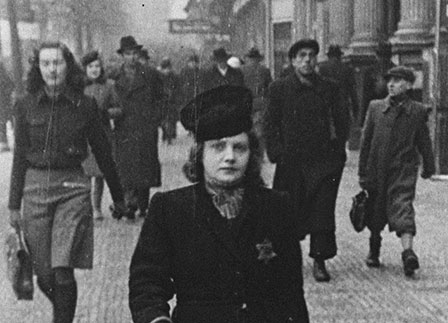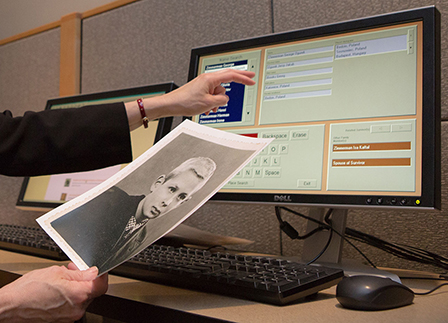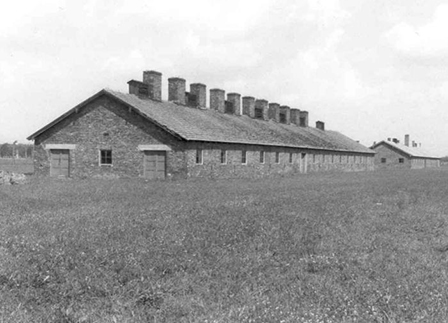Overview
- Description
- Contains one letter, a visitors pass, six photographs, and two crematorium identification tags (Dachau).
- Date
-
circa 1945
- Credit Line
- United States Holocaust Memorial Museum Collection, Gift of Ramona A. Rudulph
Physical Details
- Extent
-
1 folder
Rights & Restrictions
- Conditions on Access
- There are no known restrictions on access to this material.
- Conditions on Use
- Material(s) in this collection may be protected by copyright and/or related rights. You do not require further permission from the Museum to use this material. The user is solely responsible for making a determination as to if and how the material may be used.
Administrative Notes
- Holder of Originals
-
United States Holocaust Memorial Museum
- Legal Status
- Permanent Collection
- Provenance
- The United States Holocaust Memorial Museum Archives received this collection from Ramona Rudolph in Apr. 2003.
- Record last modified:
- 2023-02-24 13:38:39
- This page:
- http://collections.ushmm.org/search/catalog/irn46056
Download & Licensing
- In Copyright - Use Permitted
- Terms of Use
- This record is not digitized and cannot be downloaded online.
In-Person Research
- Request 7 Days in Advance of Visit
- Plan a Research Visit
-
Request in Shapell Center Reading Room
Bowie, MD
Contact Us
Also in Charles Rudulph collection
The collection consists of sixteen SS patches, two crematorium tags, correspondence, documents, and photographs relating to the experiences of Lt. Charles Rudulph, United States Army, in Germany after World War II.
Date: 1945 July
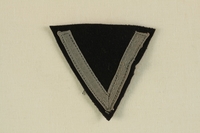
Unused Waffen SS sleeve chevron acquired postwar by a US soldier
Object
Unused Waffen SS single stripe chevron sleeve patch acquired by 22 year old Lt. Charles Rudulph, United States Army, during a July 10, 1945, visit to the former Dachau concentration camp near Munich in Germany. The badge would have been worn on the left, upper sleeve below the Reichsadler national emblem on the tunic of an SS-Sturmmann [Lance-Corporal. The SS (Schutzstaffel; Protection Squadrons) established Dachau, the first concentration camp in Nazi Germany, in March 1933. The SS commanded, administered, and guarded all concentration camps, and were known for their cruelty. Dachau was liberated by American forces on April 29, 1945. Rudulph, an officer in the 106th Infantry, entered combat in France in November 1944. He was wounded during the Battle of the Bulge but rejoined his unit. After Germany surrendered on May 7, he was posted to Straubing with Battery X, 566th AAA Battalion.
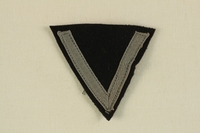
Unused Waffen SS sleeve chevron acquired postwar by a US soldier
Object
Unused Waffen SS single stripe chevron sleeve patch acquired by 22 year old Lt. Charles Rudulph, United States Army, during a July 10, 1945, visit to the former Dachau concentration camp near Munich in Germany. The badge would have been worn on the left, upper sleeve below the Reichsadler national emblem on the tunic of an SS-Sturmmann [Lance-Corporal. The SS (Schutzstaffel; Protection Squadrons) established Dachau, the first concentration camp in Nazi Germany, in March 1933. The SS commanded, administered, and guarded all concentration camps, and were known for their cruelty. Dachau was liberated by American forces on April 29, 1945. Rudulph, an officer in the 106th Infantry, entered combat in France in November 1944. He was wounded during the Battle of the Bulge but rejoined his unit. After Germany surrendered on May 7, he was posted to Straubing with Battery X, 566th AAA Battalion.
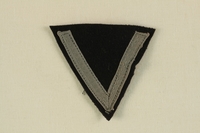
Unused Waffen SS sleeve chevron acquired postwar by a US soldier
Object
Unused Waffen SS single stripe chevron sleeve patch acquired by 22 year old Lt. Charles Rudulph, United States Army, during a July 10, 1945, visit to the former Dachau concentration camp near Munich in Germany. The badge would have been worn on the left, upper sleeve below the Reichsadler national emblem on the tunic of an SS-Sturmmann [Lance-Corporal. The SS (Schutzstaffel; Protection Squadrons) established Dachau, the first concentration camp in Nazi Germany, in March 1933. The SS commanded, administered, and guarded all concentration camps, and were known for their cruelty. Dachau was liberated by American forces on April 29, 1945. Rudulph, an officer in the 106th Infantry, entered combat in France in November 1944. He was wounded during the Battle of the Bulge but rejoined his unit. After Germany surrendered on May 7, he was posted to Straubing with Battery X, 566th AAA Battalion.
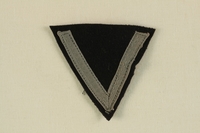
Unused Waffen SS sleeve chevron acquired postwar by a US soldier
Object
Unused Waffen SS single stripe chevron sleeve patch acquired by 22 year old Lt. Charles Rudulph, United States Army, during a July 10, 1945, visit to the former Dachau concentration camp near Munich in Germany. The badge would have been worn on the left, upper sleeve below the Reichsadler national emblem on the tunic of an SS-Sturmmann [Lance-Corporal. The SS (Schutzstaffel; Protection Squadrons) established Dachau, the first concentration camp in Nazi Germany, in March 1933. The SS commanded, administered, and guarded all concentration camps, and were known for their cruelty. Dachau was liberated by American forces on April 29, 1945. Rudulph, an officer in the 106th Infantry, entered combat in France in November 1944. He was wounded during the Battle of the Bulge but rejoined his unit. After Germany surrendered on May 7, he was posted to Straubing with Battery X, 566th AAA Battalion.
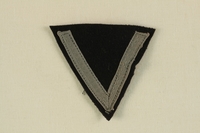
Unused Waffen SS sleeve chevron acquired postwar by a US soldier
Object
Unused Waffen SS single stripe chevron sleeve patch acquired by 22 year old Lt. Charles Rudulph, United States Army, during a July 10, 1945, visit to the former Dachau concentration camp near Munich in Germany. The badge would have been worn on the left, upper sleeve below the Reichsadler national emblem on the tunic of an SS-Sturmmann [Lance-Corporal. The SS (Schutzstaffel; Protection Squadrons) established Dachau, the first concentration camp in Nazi Germany, in March 1933. The SS commanded, administered, and guarded all concentration camps, and were known for their cruelty. Dachau was liberated by American forces on April 29, 1945. Rudulph, an officer in the 106th Infantry, entered combat in France in November 1944. He was wounded during the Battle of the Bulge but rejoined his unit. After Germany surrendered on May 7, he was posted to Straubing with Battery X, 566th AAA Battalion.
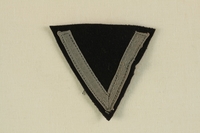
Unused Waffen SS sleeve chevron acquired postwar by a US soldier
Object
Unused Waffen SS single stripe chevron sleeve patch acquired by 22 year old Lt. Charles Rudulph, United States Army, during a July 10, 1945, visit to the former Dachau concentration camp near Munich in Germany. The badge would have been worn on the left, upper sleeve below the Reichsadler national emblem on the tunic of an SS-Sturmmann [Lance-Corporal. The SS (Schutzstaffel; Protection Squadrons) established Dachau, the first concentration camp in Nazi Germany, in March 1933. The SS commanded, administered, and guarded all concentration camps, and were known for their cruelty. Dachau was liberated by American forces on April 29, 1945. Rudulph, an officer in the 106th Infantry, entered combat in France in November 1944. He was wounded during the Battle of the Bulge but rejoined his unit. After Germany surrendered on May 7, he was posted to Straubing with Battery X, 566th AAA Battalion.
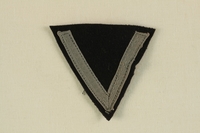
Unused Waffen SS sleeve chevron acquired postwar by a US soldier
Object
Unused Waffen SS single stripe chevron sleeve patch acquired by 22 year old Lt. Charles Rudulph, United States Army, during a July 10, 1945, visit to the former Dachau concentration camp near Munich in Germany. The badge would have been worn on the left, upper sleeve below the Reichsadler national emblem on the tunic of an SS-Sturmmann [Lance-Corporal. The SS (Schutzstaffel; Protection Squadrons) established Dachau, the first concentration camp in Nazi Germany, in March 1933. The SS commanded, administered, and guarded all concentration camps, and were known for their cruelty. Dachau was liberated by American forces on April 29, 1945. Rudulph, an officer in the 106th Infantry, entered combat in France in November 1944. He was wounded during the Battle of the Bulge but rejoined his unit. After Germany surrendered on May 7, he was posted to Straubing with Battery X, 566th AAA Battalion.
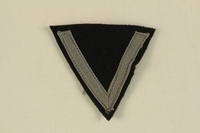
Unused Waffen SS sleeve chevron acquired postwar by a US soldier
Object
Unused Waffen SS single stripe chevron sleeve patch acquired by 22 year old Lt. Charles Rudulph, United States Army, during a July 10, 1945, visit to the former Dachau concentration camp near Munich in Germany. The badge would have been worn on the left, upper sleeve below the Reichsadler national emblem on the tunic of an SS-Sturmmann [Lance-Corporal. The SS (Schutzstaffel; Protection Squadrons) established Dachau, the first concentration camp in Nazi Germany, in March 1933. The SS commanded, administered, and guarded all concentration camps, and were known for their cruelty. Dachau was liberated by American forces on April 29, 1945. Rudulph, an officer in the 106th Infantry, entered combat in France in November 1944. He was wounded during the Battle of the Bulge but rejoined his unit. After Germany surrendered on May 7, he was posted to Straubing with Battery X, 566th AAA Battalion.
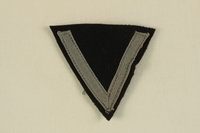
Unused Waffen SS sleeve chevron acquired postwar by a US soldier
Object
Unused Waffen SS single stripe chevron sleeve patch acquired by 22 year old Lt. Charles Rudulph, United States Army, during a July 10, 1945, visit to the former Dachau concentration camp near Munich in Germany. The badge would have been worn on the left, upper sleeve below the Reichsadler national emblem on the tunic of an SS-Sturmmann [Lance-Corporal. The SS (Schutzstaffel; Protection Squadrons) established Dachau, the first concentration camp in Nazi Germany, in March 1933. The SS commanded, administered, and guarded all concentration camps, and were known for their cruelty. Dachau was liberated by American forces on April 29, 1945. Rudulph, an officer in the 106th Infantry, entered combat in France in November 1944. He was wounded during the Battle of the Bulge but rejoined his unit. After Germany surrendered on May 7, he was posted to Straubing with Battery X, 566th AAA Battalion.
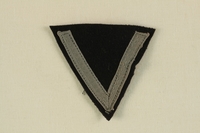
Unused Waffen SS sleeve chevron acquired postwar by a US soldier
Object
Unused Waffen SS single stripe chevron sleeve patch acquired by 22 year old Lt. Charles Rudulph, United States Army, during a July 10, 1945, visit to the former Dachau concentration camp near Munich in Germany. The badge would have been worn on the left, upper sleeve below the Reichsadler national emblem on the tunic of an SS-Sturmmann [Lance-Corporal. The SS (Schutzstaffel; Protection Squadrons) established Dachau, the first concentration camp in Nazi Germany, in March 1933. The SS commanded, administered, and guarded all concentration camps, and were known for their cruelty. Dachau was liberated by American forces on April 29, 1945. Rudulph, an officer in the 106th Infantry, entered combat in France in November 1944. He was wounded during the Battle of the Bulge but rejoined his unit. After Germany surrendered on May 7, he was posted to Straubing with Battery X, 566th AAA Battalion.
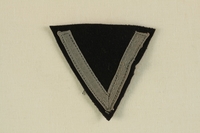
Unused Waffen SS sleeve chevron acquired postwar by a US soldier
Object
Unused Waffen SS single stripe chevron sleeve patch acquired by 22 year old Lt. Charles Rudulph, United States Army, during a July 10, 1945, visit to the former Dachau concentration camp near Munich in Germany. The badge would have been worn on the left, upper sleeve below the Reichsadler national emblem on the tunic of an SS-Sturmmann [Lance-Corporal. The SS (Schutzstaffel; Protection Squadrons) established Dachau, the first concentration camp in Nazi Germany, in March 1933. The SS commanded, administered, and guarded all concentration camps, and were known for their cruelty. Dachau was liberated by American forces on April 29, 1945. Rudulph, an officer in the 106th Infantry, entered combat in France in November 1944. He was wounded during the Battle of the Bulge but rejoined his unit. After Germany surrendered on May 7, he was posted to Straubing with Battery X, 566th AAA Battalion.
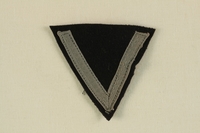
Unused Waffen SS sleeve chevron acquired postwar by a US soldier
Object
Unused Waffen SS single stripe chevron sleeve patch acquired by 22 year old Lt. Charles Rudulph, United States Army, during a July 10, 1945, visit to the former Dachau concentration camp near Munich in Germany. The badge would have been worn on the left, upper sleeve below the Reichsadler national emblem on the tunic of an SS-Sturmmann [Lance-Corporal. The SS (Schutzstaffel; Protection Squadrons) established Dachau, the first concentration camp in Nazi Germany, in March 1933. The SS commanded, administered, and guarded all concentration camps, and were known for their cruelty. Dachau was liberated by American forces on April 29, 1945. Rudulph, an officer in the 106th Infantry, entered combat in France in November 1944. He was wounded during the Battle of the Bulge but rejoined his unit. After Germany surrendered on May 7, he was posted to Straubing with Battery X, 566th AAA Battalion.
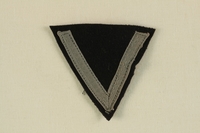
Unused Waffen SS sleeve chevron acquired postwar by a US soldier
Object
Unused Waffen SS single stripe chevron sleeve patch acquired by 22 year old Lt. Charles Rudulph, United States Army, during a July 10, 1945, visit to the former Dachau concentration camp near Munich in Germany. The badge would have been worn on the left, upper sleeve below the Reichsadler national emblem on the tunic of an SS-Sturmmann [Lance-Corporal. The SS (Schutzstaffel; Protection Squadrons) established Dachau, the first concentration camp in Nazi Germany, in March 1933. The SS commanded, administered, and guarded all concentration camps, and were known for their cruelty. Dachau was liberated by American forces on April 29, 1945. Rudulph, an officer in the 106th Infantry, entered combat in France in November 1944. He was wounded during the Battle of the Bulge but rejoined his unit. After Germany surrendered on May 7, he was posted to Straubing with Battery X, 566th AAA Battalion.
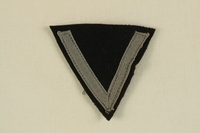
Unused Waffen SS sleeve chevron acquired postwar by a US soldier
Object
Unused Waffen SS single stripe chevron sleeve patch acquired by 22 year old Lt. Charles Rudulph, United States Army, during a July 10, 1945, visit to the former Dachau concentration camp near Munich in Germany. The badge would have been worn on the left, upper sleeve below the Reichsadler national emblem on the tunic of an SS-Sturmmann [Lance-Corporal. The SS (Schutzstaffel; Protection Squadrons) established Dachau, the first concentration camp in Nazi Germany, in March 1933. The SS commanded, administered, and guarded all concentration camps, and were known for their cruelty. Dachau was liberated by American forces on April 29, 1945. Rudulph, an officer in the 106th Infantry, entered combat in France in November 1944. He was wounded during the Battle of the Bulge but rejoined his unit. After Germany surrendered on May 7, he was posted to Straubing with Battery X, 566th AAA Battalion.
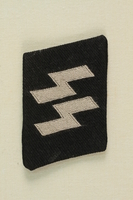
Unused Waffen-SS collar tab acquired postwar by a US soldier
Object
Unused Waffen SS collar tab with lightning bolt insignia acquired by 22 year old Lt. Charles Rudulph, United States Army, during a July 10, 1945, visit to the former Dachau concentration camp near Munich in Germany. The tab would have been worn in a pair on the collar points of a uniform shirt or jacket. The SS (Schutzstaffel; Protection Squadrons) established Dachau, the first concentration camp in Nazi Germany, in March 1933. The SS commanded, administered, and guarded all concentration camps, and were known for their cruelty. Dachau was liberated by American forces on April 29, 1945. Rudulph, an officer in the 106th Infantry, entered combat in France in November 1944. He was wounded during the Battle of the Bulge but rejoined his unit. After Germany surrendered on May 7, he was posted to Straubing with Battery X, 566th AAA Battalion.
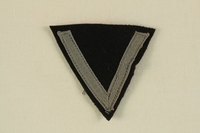
Unused Waffen SS sleeve chevron acquired postwar by a US soldier
Object
Unused Waffen SS single stripe chevron sleeve patch acquired by 22 year old Lt. Charles Rudulph, United States Army, during a July 10, 1945, visit to the former Dachau concentration camp near Munich in Germany. The badge would have been worn on the left, upper sleeve below the Reichsadler national emblem on the tunic of an SS-Sturmmann [Lance-Corporal. The SS (Schutzstaffel; Protection Squadrons) established Dachau, the first concentration camp in Nazi Germany, in March 1933. The SS commanded, administered, and guarded all concentration camps, and were known for their cruelty. Dachau was liberated by American forces on April 29, 1945. Rudulph, an officer in the 106th Infantry, entered combat in France in November 1944. He was wounded during the Battle of the Bulge but rejoined his unit. After Germany surrendered on May 7, he was posted to Straubing with Battery X, 566th AAA Battalion.
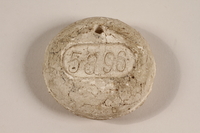
Crematorium tag, number 5896, acquired at Dachau postwar by a US soldier
Object
Unused clay crematorium disc with the number 5896 acquired by 22 year old Lt. Charles Rudulph, United States Army, during a July 10, 1945, tour of the crematorium of Dachau concentration camp near Munich in Germany. This type of disc was placed with a body to identify the ashes after cremation. The numbers do not correspond to prisoner numbers. Rudulph found it in what he called the murder house, with the cremation urns in a cellar between the room where bodies were stored and the ovens. Dachau was the first concentration camp established by the SS in March 1933, originally for political prisoners. Over time, other groups were interned there, including Jehovah's Witnesses, Roma, homosexuals, repeat criminal offenders, and Jews. The camp was liberated by American forces on April 29, 1945. Rudulph, an officer in the 106th Infantry, entered combat in France in November 1944. He was wounded during the Battle of the Bulge but rejoined his unit. After Germany surrendered on May 7, he was posted to Straubing with Battery X, 566th AAA Battalion.
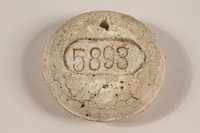
Crematorium tag, number 5893, acquired at Dachau postwar by a US soldier
Object
Unused clay crematorium disc with the number 5893 acquired by 22 year old Lt. Charles Rudulph, United States Army, during a July 10, 1945, tour of the crematorium at Dachau concentration camp near Munich, Germany. This type of disc was placed with a body to identify the ashes after cremation. The numbers do not correspond to prisoner numbers. Rudulph found it in what he called the murder house, with the cremation urns in a cellar between the room where bodies were stored and the ovens. Dachau was the first concentration camp established by the SS in March 1933, originally for political prisoners. Over time, other groups were interned there, including Jehovah's Witnesses, Roma, homosexuals, repeat criminal offenders, and Jews. The camp was liberated by American forces on April 29, 1945. Rudulph, an officer in the 106th Infantry, entered combat in France in November 1944. He was wounded during the Battle of the Bulge but rejoined his unit. After Germany surrendered on May 7, he was posted to Straubing with Battery X, 566th AAA Battalion.

